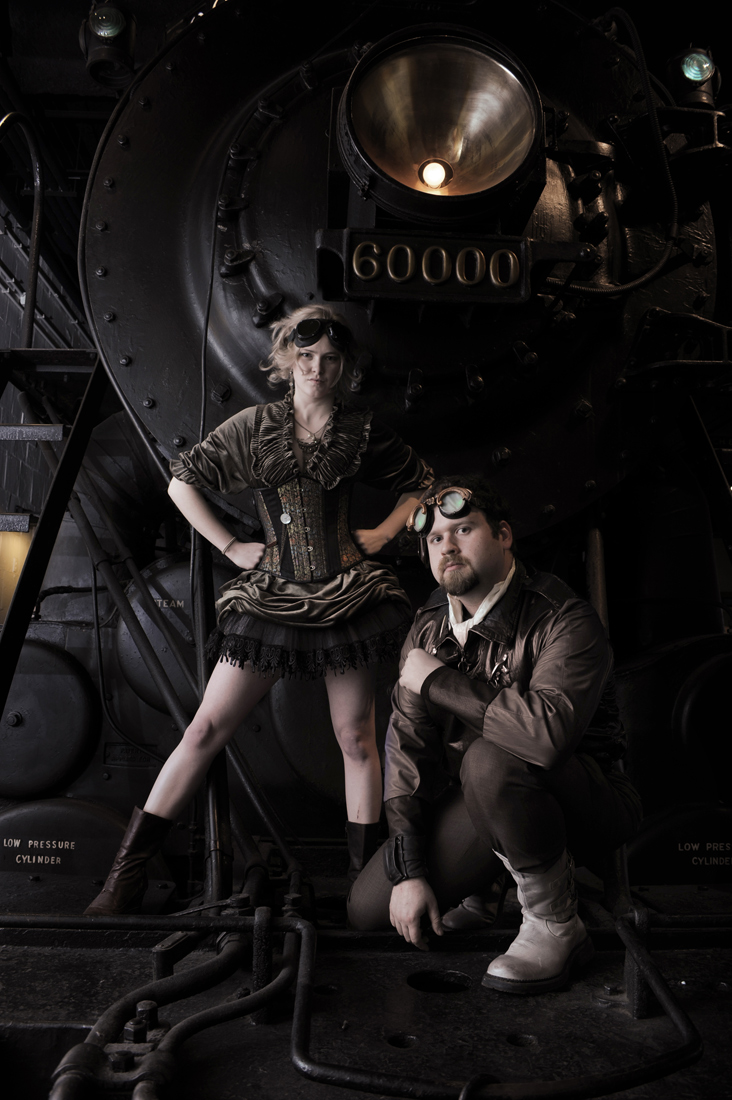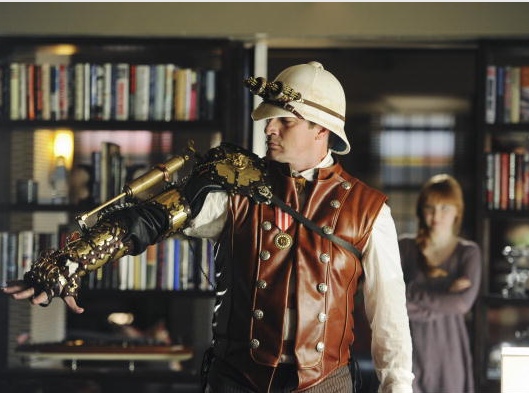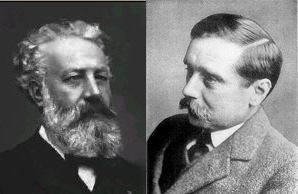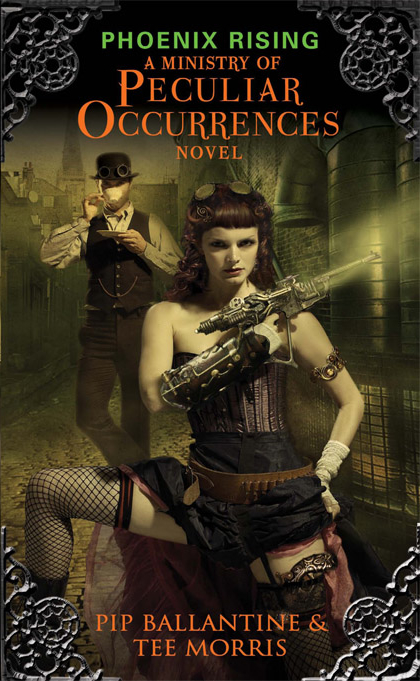 Quite often, we receive queries at the Ministry of Peculiar Occurrences that extend beyond our usual fare. While we hardly categorize “My cat is coughing up hairballs that move…” and “My teenage daughter simply won’t listen to her father…” worthy of our attention, one often asked question does give us pause…
Quite often, we receive queries at the Ministry of Peculiar Occurrences that extend beyond our usual fare. While we hardly categorize “My cat is coughing up hairballs that move…” and “My teenage daughter simply won’t listen to her father…” worthy of our attention, one often asked question does give us pause…“What is Steampunk?”
Depending on which resource you reference, be it the Wikipedia entry (featuring our good friend and creative talent, Jared Axelrod in this photo by Kyle Cassidy, licensed under Creative Commons 3.0) or Steampunk.com, you will find a variety of answers and interpretations to this creative movement that has been growing in popularity, but also capturing mainstream curiosity.We at the Ministry, based on our own research and passions on the subject, have compiled a page that offers several descriptions of what we believe constitutes steampunk. We begin with an “elevator pitch” to start, and then work up to the “deep dive” that not only touches on the foundations of the genre, but even touches on the debate making rounds online and at the cons.
So without further ado…
A Quick Explanation, Old Boy. I just put the kettle on.
Steampunk is modern technology—iPads, computers, robotics, air travel—powered by steam and set in the 1800’s.
This is as brief and as compact a description you can give people that have no clue what steampunk is. Perhaps the most recent mainstream point of reference would be the episode “Punked” from ABC’s popular crime drama, Castle (seen above, with Nathan Fillion featuring an armoured forearm creation from Brute Force Studios).
A Few More Details, if you please…
Steampunk is an inspired movement of creativity and imagination. With a backdrop of either Victorian England or America’s Wild West at hand, modern technologies are re-imagined and realized as elaborate works of art, fashion, and mechanics. If Jules Verne or H.G. Wells were writing their science fiction today, it would be considered “steampunk.”
Moving beyond the elevator pitch, this brief summary names two of steampunk’s most revered heroes, Jules Verne and H.G. Wells (pictured above). While Verne and Wells are regarded as part of the foundation of Science Fiction, they would be listed as steampunk authors if they were writing their works today.
The Deep Dive…20,000 Leagues or so…
 The term “Steampunk” originated in the late 1980s with a cheeky letter to Locus Magazine from science fiction author K. W. Jeter. Jeter was trying to find an accurate description of works by himself (Morlock Night), Tim Powers (The Anubis Gates), and James Blaylock (Homunculus). While Jeter coined the word, it was William Gibson and Bruce Sterling that brought the genre attention with the book The Difference Engine (1992). Best known for their offerings in cyberpunk, Gibson and Sterling took their intimate integration of man and machine back to 1885.
The term “Steampunk” originated in the late 1980s with a cheeky letter to Locus Magazine from science fiction author K. W. Jeter. Jeter was trying to find an accurate description of works by himself (Morlock Night), Tim Powers (The Anubis Gates), and James Blaylock (Homunculus). While Jeter coined the word, it was William Gibson and Bruce Sterling that brought the genre attention with the book The Difference Engine (1992). Best known for their offerings in cyberpunk, Gibson and Sterling took their intimate integration of man and machine back to 1885. In this alternative Industrial Revolution, Charles Babbage’s Difference Engine is not merely a curiosity but the norm, and now his Analytical Engine comes to fruition. The book centres around the struggle between the working class Luddites (who fear technology) and the upper-class “enhanced” elite.
From here, the steampunk movement gained momentum, although there are some cinematic and televised works that could easily be considered steampunk while pre-dating The Difference Engine by three decades or more.
Over the years, steampunk has evolved into more than just a sub-genre of Science Fiction and Fantasy. Steampunk now extends into fashion, engineering, music, and for some, a lifestyle. With the Victorian British Empire or American Wild West as the backdrop, steampunk projects are a challenge of making something elegant out of random bits and bobs.
Picture MacGyver or The A-Team in the 1800’s. Consider Dick Van Dyke’s Caractacus Potts and his creations in Chitty Chitty Bang Bang, or the ingenious contraptions from Artimus Gordon’s laboratory in the television show The Wild, Wild West. What others see as junk or scrap parts, steampunk artists transform it into something new and expressive, be it an original creation or a modification of a modern convenience.
Where exactly does the “punk” come into play?
A current debate amongst writers is that the growing commercialism over the genre has diluted the “punk” aspect of steampunk. Their argument is that steampunk has been reduced to a backdrop of romantic Victoriana, goggles, and brass fixtures. Instead of works like The Difference Engine, The Diamond Age, and The Windup Girl where social commentary and dystopia are the focus, the grittiness and edge of steampunk is merely a shiny, spiffy backdrop as seen in lighter works such as Soulless and Girl Genius.Steampunk, at least the way we see it, gets its “punk” not in its dystopian view of the world or even in its gritty edge. The “punk” in “Steampunk” comes from going against convention that, through creativity and declaration of one’s individuality be it through style, gadgets, or attitude, sets one apart. In our own work, the “punk” is embodied in Eliza D. Braun, an agent from New Zealand.
Coming from the farthest reaches of the Empire where women have the right to vote, where the “natives” co-exist with the “colonials,” and where everyone speaks their mind frankly and honestly, she goes against the standard norms at the home office in London, England. She is paired up with Wellington Thornhill Books, Esquire, a man of the manor born now serving at the Queen’s pleasure. She is everything he is not, and vice versa; and it is their chemistry and unorthodox approach to peculiar occurrences that make them unique within a society based on conformity.
All this, and they’re having a smashing good time while doing it. Well, at least, Eliza is.
Perhaps the best published primer for understanding steampunk, we found, is the unassuming title Steampunk Style Jewelry by Jean Campbell. Outside of Amazon.com, you can find this book at your local Michael’s or arts-and-crafts store. As expected, there are plenty of how-to projects, but you will also find columns by musicians, artists, and seamstresses on what steampunk is. The photography in this book is also quite stunning.
And, of course, if you want to experience just how much fun steampunk can be, take a look at Phoenix Rising: A Ministry of Peculiar Occurrences Novel





0 Comments::
Post a Comment
Hope you enjoyed :)